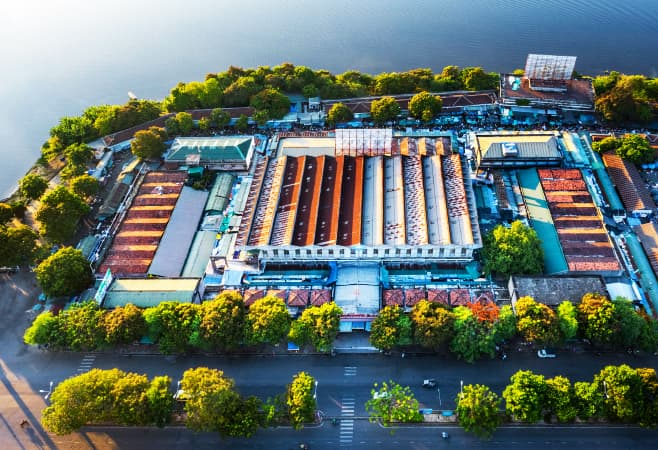Hue in Vietnam: A Cultural and Historical Journey
Nestled along the serene banks of the Perfume River, Hue in Vietnam is a city where time seems to have paused. This former imperial capital, renowned for its rich history and cultural significance, exudes an aura of elegance and nostalgia. Tourists become enchanted by both the Nguyen Dynasty royal artifacts and the poetic natural surroundings and the ancient temples that exist within the city. Hue is widely regarded by the Vietnamese cultural community as a symbol of national heritage and identity, especially due to its historical role as the capital of the Nguyen Dynasty.
- Hue in Vietnam: A cultural jewel of central Vietnam
- Imperial city of Hue: A UNESCO World Heritage Site
- The royal tombs of Hue
- Thien Mu Pagoda: Hue’s spiritual landmark
- Perfume River: Lifeline of Hue
- Hue's Pagodas and temples: A sacred trail
- Traditional cuisine of Hue: Royal flavors on a plate
- Markets in Hue: Local treasures and artisan finds
- Beaches near Hue: A hidden coastal escape
- Exploring Hue by bicycle: A peaceful adventure
- Hue’s colonial past: Traces of French Influence
- Local experiences in Hue: Off-the-beaten-path activities
- Best time to visit Hue in Vietnam
- How to get to Hue and travel around
- Where to stay in Hue: Hotels for every budget
- Safety tips and cultural etiquette in Hue
- Photography tips for capturing Hue’s essence
- Frequently asked questions about Hue in Vietnam
- Conclusion: Hue in Vietnam
Hue in Vietnam: A cultural jewel of central Vietnam
Hue exists as a critical connection point that links the northern and southern parts of Vietnam. The location near major cities and East Sea proximity gives Hue an all-round pleasant tropical climate throughout most months. The city of Hue gains cultural appeal because it sits between mountain ranges and coastal lowlands.
The ancient capital of the Nguyen Dynasty
During 1802 to 1945, Hue functioned as the royal capital of Vietnam under the Nguyen Dynasty. Emperors who once governed Vietnam chose this city to build magnificent citadels along with complex tombs and beautiful pagodas. Through its captivating regal architecture and ceremonial traditions Hue preserves the enduring legacy of its emperors to showcase an era of Vietnamese aristocracy from the past.
Imperial city of Hue: A UNESCO World Heritage Site
One of Vietnam's most magnificent architectural achievements stands in Hue City which contains the Imperial City. The UNESCO World Heritage Site stands as a dynastic museum protected by a huge fortress surrounded by a moat.
History and architecture of the citadel
The Citadel received its construction during the early 19th century while geomancy and military strategy from China provided its design principles. The site arranges its buildings according to Feng Shui protocol through gate placements that shield the emperor and royal members. Inside, you’ll find the Purple Forbidden City, royal palaces and the grand Ngo Mon Gate - all resonating with detailed carvings, lacquered interiors and golden motifs.
Must-visit sites within the Imperial City
- Thai Hoa Palace – where coronations took place.
- Dien Tho Residence – the queen mother’s domain.
- Truong Sanh Residence – a quieter, picturesque corner.
- Nine Dynastic Urns – each urn symbolizes a different Nguyen emperor.
These structures stand as proud testaments to Vietnam's regal past, echoing stories of court intrigue, poetry and politics.

Imperial Royal Palace of the Nguyen dynasty in Hue
The royal tombs of Hue
Scattered across the countryside, the royal tombs of Hue are much more than burial sites - they’re monumental reflections of each emperor’s philosophy and legacy.
Emperor Khai Dinh Tomb
This tomb dazzles with its blend of Western and Eastern design. Climb the steep stairs and behold a surreal fusion of Gothic elements, colorful mosaics and dragon motifs guarding the remains of a ruler who adored modernity.
Emperor Minh Mang Tomb
Located in natural surroundings the tomb harmoniously combines with its environment through its placement within landscaped gardens and lotus ponds and pine trees. The structure expresses Confucian principles by displaying balanced symmetry throughout its structure.
Emperor Tu Duc Tomb
Perhaps the most poetic of all, Tu Duc’s tomb is a sanctuary of reflection. The emperor, a scholar and poet, designed it as his retirement retreat long before his death. The tranquil lake combined with the pavilion reveals wisdom about being alone with oneself.
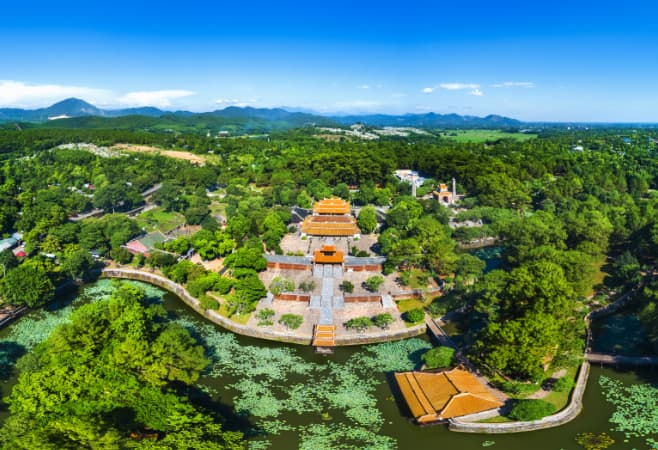
Gardens Of Tu Duc Emperor near Hue, Vietnam
Thien Mu Pagoda: Hue’s spiritual landmark
Among all the landmarks in Hue city, Thien Mu Pagoda stands as the most famous structure because it soars above the Perfume River from its hilltop position. Since the time of its construction Phuoc Duyen tower has served as a spiritual center and political hub for hundreds of years.
Legend behind the pagoda
According to legend, an old woman predicted the rise of a great temple here. The story reached Lord Nguyen Hoang who decided to construct the pagoda as a divine omen. Monks together with mystics have maintained their spiritual journeys along this stone path since its construction.
Best time to visit
Come during sunrise or sunset for ethereal views and fewer tourists. The morning prayers of monks create an enchanting atmosphere which photos cannot effectively represent.
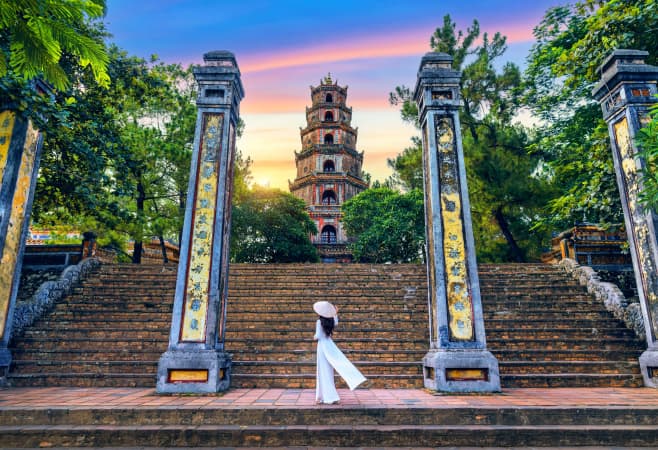
Tourists visit around the Thien Mu Pagoda, Hue in Vietnam
Perfume River: Lifeline of Hue
The Perfume River functions as the life force of Hue in Vietnam yet provides scenic charm as “Sông Hương” throughout its waterways. The Perfume River functions as a tranquil silver ribbon which connects historical landmarks together with daily life activities while it defines Hue's spirit.
Scenic boat rides and sunset cruises
Passengers should experience the traditional dragon boat voyage on the Perfume River because it offers an unforgettable journey. The colorful dragon boats operated by local families provide scenic tours which showcase Thien Mu Pagoda and the Imperial Citadel. You should choose an evening boat ride to see the sky transform into amber and pink hues which create a peaceful reflection on the calm waters.
The musical element known as "Ca Huế" is often performed on dragon boat tours, adding a traditional soundscape to the journey
Famous bridges over the Perfume River
The bridges in Hue function as structural marvels that also possess storytelling abilities. The six-span iron structure Trang Tien Bridge which the French constructed in the late 19th century creates a graceful visual appearance during nighttime illumination. Different stages in Hue's historical timeline are revealed through individual color changes of the LED lights.
Then there’s Da Vien Bridge, offering modern aesthetics and stunning views of both the riverbanks and the historical relics flanking them.
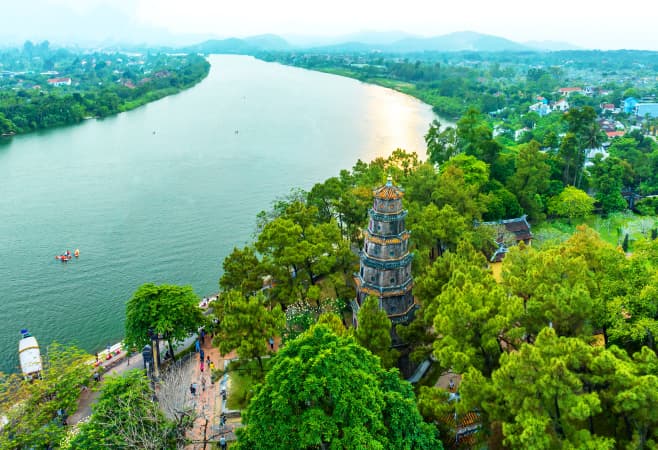
Aerial view of Thien Mu Pagoda is one of the ancient pagoda
Hue's Pagodas and temples: A sacred trail
Religion in Hue is omnipresent yet peaceful. The city’s Buddhist pagodas and Confucian temples speak of devotion, architecture and resilience.
Tu Hieu Pagoda
Royal eunuchs who served the Imperial Court rest in the tranquil Tu Hieu temple which is located within pine tree forests. The temple maintains its spiritual activity through active monk meditation while visitors practice silent contemplation. The forested region surrounding the site creates a peaceful environment that removes visitors from the city's noise.
Bao Quoc Temple
Bao Quoc Temple exists as a national treasure that originated in the 17th century. The temple contains both a famous Buddhist educational institution and a grand Buddha statue. The site provides knowledge about religious instruction together with historical information about the Nguyen Dynasty period.
Traditional cuisine of Hue: Royal flavors on a plate
Hue serves as the epitome of refined elements in the Vietnamese recipe. Royal cuisine from Hue was first created to prepare elaborate meals containing one hundred dishes for imperial consumption. Today, many of these culinary treasures are available to all.
Must-try dishes
- “Bún bò Huế – A spicy beef noodle soup that puts pho to the test.
- “Bánh bèo” – Steamed rice cakes topped with shrimp and scallion oil.
- “Nem lụi” – Lemongrass skewers grilled to perfection.
- “Cơm hến” – Rice with tiny clams, peanuts and crispy pork skin.
Where to eat authentic Hue Food
For a truly local taste, try Dong Ba Market, where street vendors whip up steaming bowls and sizzling platters. For royal-style dining, head to Ancient Hue Restaurant, where you’ll be served like emperors of old in a traditional garden setting.
Markets in Hue: Local treasures and artisan finds
Markets in Hue aren’t just for shopping - they’re sensory adventures.
Dong Ba market experience
The hub features every item including spices and textiles as well as live frogs and flower garlands. Local residents interact with experienced skill and the market smells of lemongrass mixed with roasted meat. Be sure to pick up a non la (conical hat) or Hue silk scarf - perfect souvenirs that carry the scent of tradition.
Shopping for Ao Dai and local crafts
Hue is one of the few places where you can still have a tailor-made Ao Dai - the elegant national dress of Vietnam. Visit artisan shops in the Phu Cam area or near the Citadel to find handmade incense, lacquerware and bamboo crafts.
Aerial view of Dong Ba Market near Perfume river or Huong river, Hue city, Vietnam
Beaches near Hue: A hidden coastal escape
While often overshadowed by its cultural heritage, Hue’s coastline is a dreamy escape.
Thuan An beach
Just 15 km from the city, Thuan An is a serene spot with gentle waves and soft sand. You’ll mostly share it with locals - fishing boats dot the horizon and children play in the surf at sunset.
Lang Co beach
Further south, Lang Co is a crescent-shaped paradise framed by mountains and palm trees. It’s ideal for swimming, picnicking or simply unwinding with a coconut in hand.
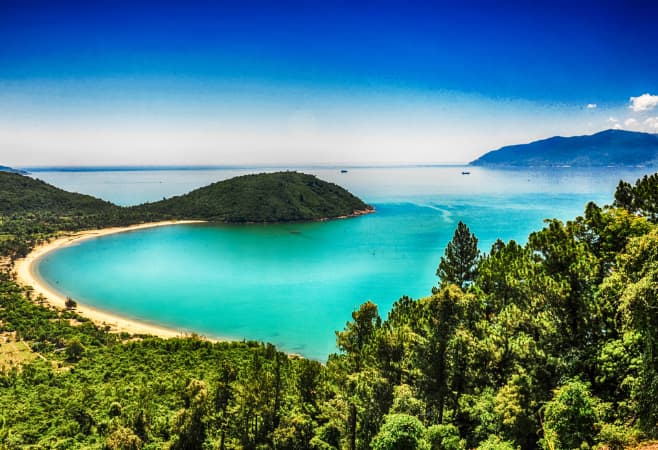
Lang Co Bay in Thua Thien Hue Province, Vietnam
Exploring Hue by bicycle: A peaceful adventure
Cycling is one of the best ways to experience Hue’s slow-paced charm.
Best routes and rentals
Popular bike routes include the ride from the Citadel to Thien Mu Pagoda, the Royal Tomb Trail and the countryside lanes past lotus ponds and rice paddies. Eco-friendly bike rentals can be found at most hostels and hotels.
Biking etiquette in Hue
Locals are friendly, but roads can be chaotic. Always ride on the right, use a bell to signal and greet passersby with a cheerful “Xin chào!”
Hue’s colonial past: Traces of French Influence
While Hue is known for its imperial Vietnamese legacy, its colonial past under French rule has also left a tangible mark on the city’s architecture and culture.
Colonial architecture and villas
Throughout Hue, you’ll find elegant French villas with wrought-iron balconies, pastel facades and arched windows. The Quoc Hoc High School, established in 1896, is one of the oldest and most prestigious schools in Vietnam, reflecting a blend of French design and Vietnamese heritage.
Walk down Le Loi Street and you’ll notice buildings that once housed colonial administrators, now repurposed into boutique hotels, galleries and cafés.
The legacy of French education and religion
French influence introduced Western-style education and Christianity to Hue. Notre Dame Cathedral in Phu Cam is a striking example of neo-Gothic religious architecture and remains an important place of worship today. While French influence introduced Christian schools and architecture, today's education system is fully nationalized. Catholic schools, once run by missionaries, played a significant role in shaping the city’s academic excellence.
Local experiences in Hue: Off-the-beaten-path activities
Beyond the well-trodden tourist sites, Hue offers authentic local experiences that bring you closer to its people and traditions.
Village tours and handicraft workshops
Visiting villages like Thanh Tien (paper flower village) or Thuy Bieu (grapefruit village) lets you see the artistry of everyday life. Join a workshop to learn how to make paper flowers, incense or even conical hats - skills passed down through generations.
Tea drinking with locals
Tea houses in Hue are not just places to sip a warm brew; they’re cultural hubs. Sit down with a local family or in a tranquil teahouse and enjoy lotus tea or green tea infused with ginger and lemongrass. It’s a simple but soulful experience, often accompanied by stories about Hue’s past.
Best time to visit Hue in Vietnam
Weather plays a huge role in shaping your experience in Hue, as the city experiences distinct dry and rainy seasons.
Weather seasons and festivals
- March to August: The dry season, with warm temperatures and plenty of sunshine - ideal for sightseeing.
- September to January: Rainy and sometimes flood-prone but perfect for cozying up in cafés or enjoying misty views of the Perfume River.
- April and May: Best for catching the Hue Festival, when the city transforms into a cultural extravaganza.
Travel tips by month
| Month | Travel Tip |
| January | Cool and quiet - great for photographers. |
| April | Festival season, but book early. |
| June | Beach weather, perfect for Lang Co. |
| October | Wet season begins - bring waterproof gear. |
How to get to Hue and travel around
Flights, trains and buses
- Flights: The Phu Bai International Airport (HUI) offers domestic flights from Hanoi, Ho Chi Minh City and Da Nang.
- Train: The Reunification Express passes through Hue and is a scenic way to travel.
- Buses: Budget-friendly and convenient from neighboring cities.
Getting around: Cyclos, bikes and boats
Hue's compact layout makes it easy to explore. Hire a cyclo for a relaxed city tour, rent a bicycle to cruise the countryside or hop on a dragon boat for a water-bound journey through history.
Where to stay in Hue: Hotels for every budget
Budget guesthouses and hostels
Backpackers can find clean, comfortable stays in the Pham Ngu Lao area, including:
- Hue Happy Homestay
- Sunny A Hotel
These offer local breakfasts and warm hospitality.
Luxury resorts and boutique hotels
For indulgent experiences, consider:
- Azerai La Residence Hue – A riverside French colonial mansion with luxury rooms and a stunning saltwater pool. This heritage property blends vintage charm with modern sophistication.
- Pilgrimage Village – A peaceful resort blending Vietnamese tradition with modern elegance, nestled in a lush green setting. It’s perfect for those seeking tranquility and a taste of Hue’s cultural soul.
- Angsana Lang Co Hue – A vibrant beachfront resort located in Lang Co Bay, offering contemporary luxury with a splash of color and adventure. Perfect for families and active travelers, with water sports, spa treatments and local excursions.
- Banyan Tree Lang Co Hue – A serene hideaway offering ultra-luxurious private villas with plunge pools and panoramic mountain or sea views. Ideal for couples and honeymooners looking for privacy, indulgence and world-class service.
Safety tips and cultural etiquette in Hue
Hue is generally safe, but like any tourist destination, a little caution goes a long way.
Dress codes and temple behavior
- Wear modest clothing when visiting pagodas or royal tombs.
- Remove shoes before entering sacred spaces.
- Avoid public displays of affection - locals are quite conservative.
Avoiding tourist scams
- Agree on cyclo or taxi fares before the ride.
- Use trusted tour operators.
- Be cautious of overly persistent vendors in markets.
Photography tips for capturing Hue’s essence
With its atmospheric fog, golden sunrises and regal ruins, Hue is a dream for shutterbugs.
Golden hours and top spots
- Sunrise at Thien Mu Pagoda
- Sunset at Perfume River docks
- Imperial City during golden hour for dramatic light
Ethical photography practices
- Always ask before taking portraits, especially in rural areas.
- Avoid flash in sacred places.
- Share photos with locals if possible - it builds meaningful connections.
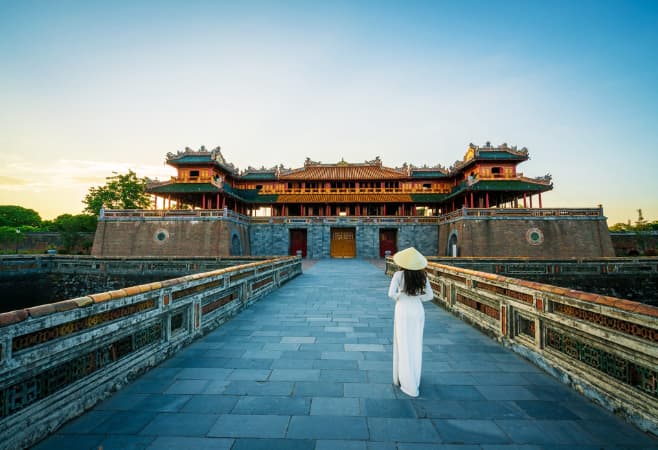
Ngo Mon gate - the main entrance of former Hue Imperial City in Hue city, Vietnam
Frequently asked questions about Hue in Vietnam
- Is Hue worth visiting in Vietnam?
Absolutely! With its imperial heritage, rich culture and tranquil beauty, Hue offers a unique blend of history and relaxation that few cities can match.
- How many days should I spend in Hue?
Three days is ideal to explore the Imperial City, royal tombs, local cuisine and nearby beaches without feeling rushed.
- What's the best way to travel from Da Nang to Hue?
The Hai Van Pass is a scenic route and you can take a train, bus or hire a motorbike for an unforgettable ride.
- What food is Hue famous for?
Hue is renowned for dishes like Bún bò Huế, bánh bèo, nem lụi and royal vegetarian cuisine.
- Is Hue safe for solo travelers?
Yes, Hue is considered one of the safer destinations in Vietnam. Locals are welcoming and crime rates are low.
- When is the Hue Festival held?
It’s usually every two years in April or June. Check the official website for updated schedules and events.
Conclusion: Hue in Vietnam
Whether you're a history buff, a foodie, a spiritual seeker or just someone craving serenity, Hue in Vietnam delivers on every front. It’s a city where emperors once dreamed, monks still chant and the Perfume River whispers stories of love, loss and legacy. From ornate tombs to steaming bowls of noodle soup, from colonial echoes to local laughter, Hue offers more than a trip - it offers a timeless experience.
Related Articles
- Moc Chau: Highland paradise of tea hills & cultural adventures
- Team building and CSR activities in Vietnam: Visa services
- Honeymoon in Vietnam: Best romantic packages for couples
- Amanoi Resort in Vietnam: Luxury retreat in Vinh Hy Bay
- Six Senses resorts in Vietnam: Ninh Van Bay and Con Dao
- Con Dao Island: A historical and natural paradise in Vietnam
HOW CAN WE HELP?
APPLY WITH CONFIDENCE

